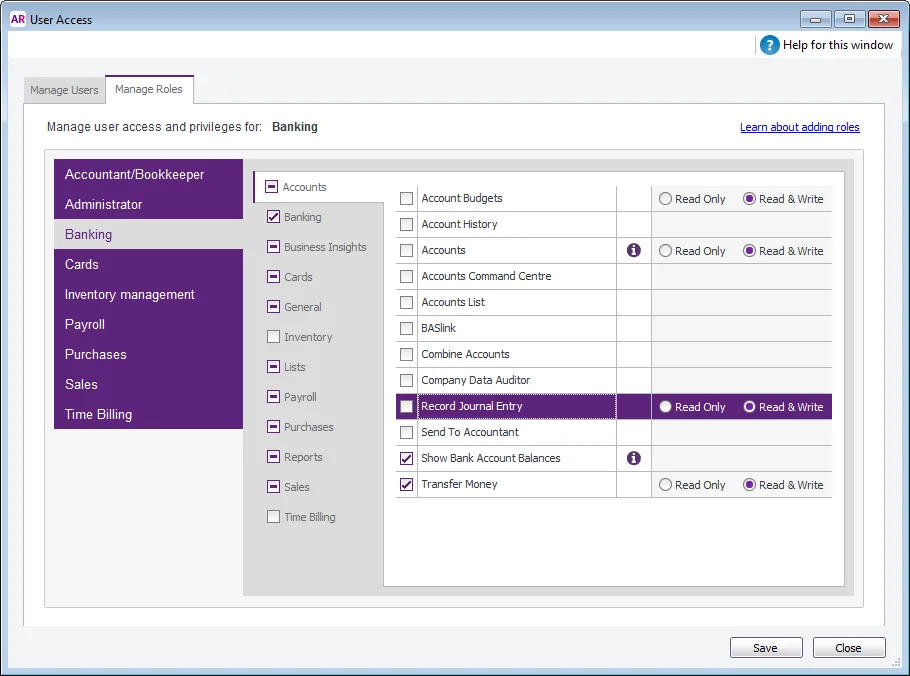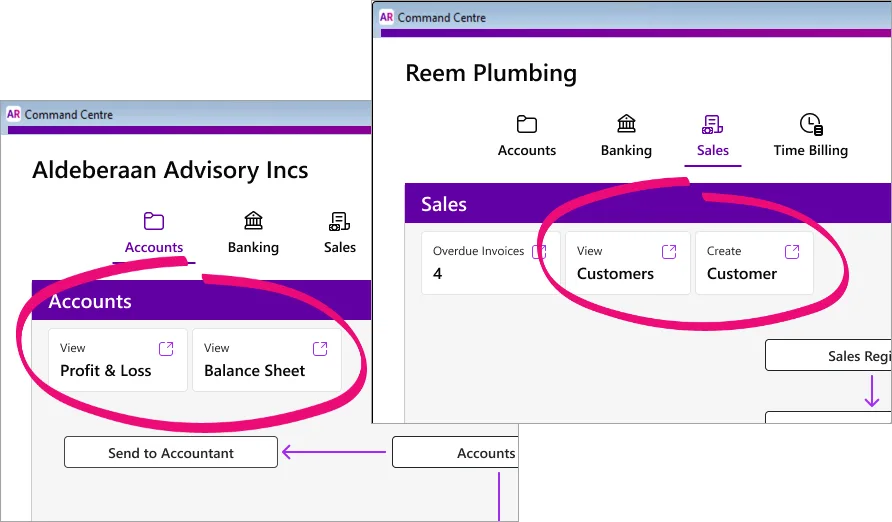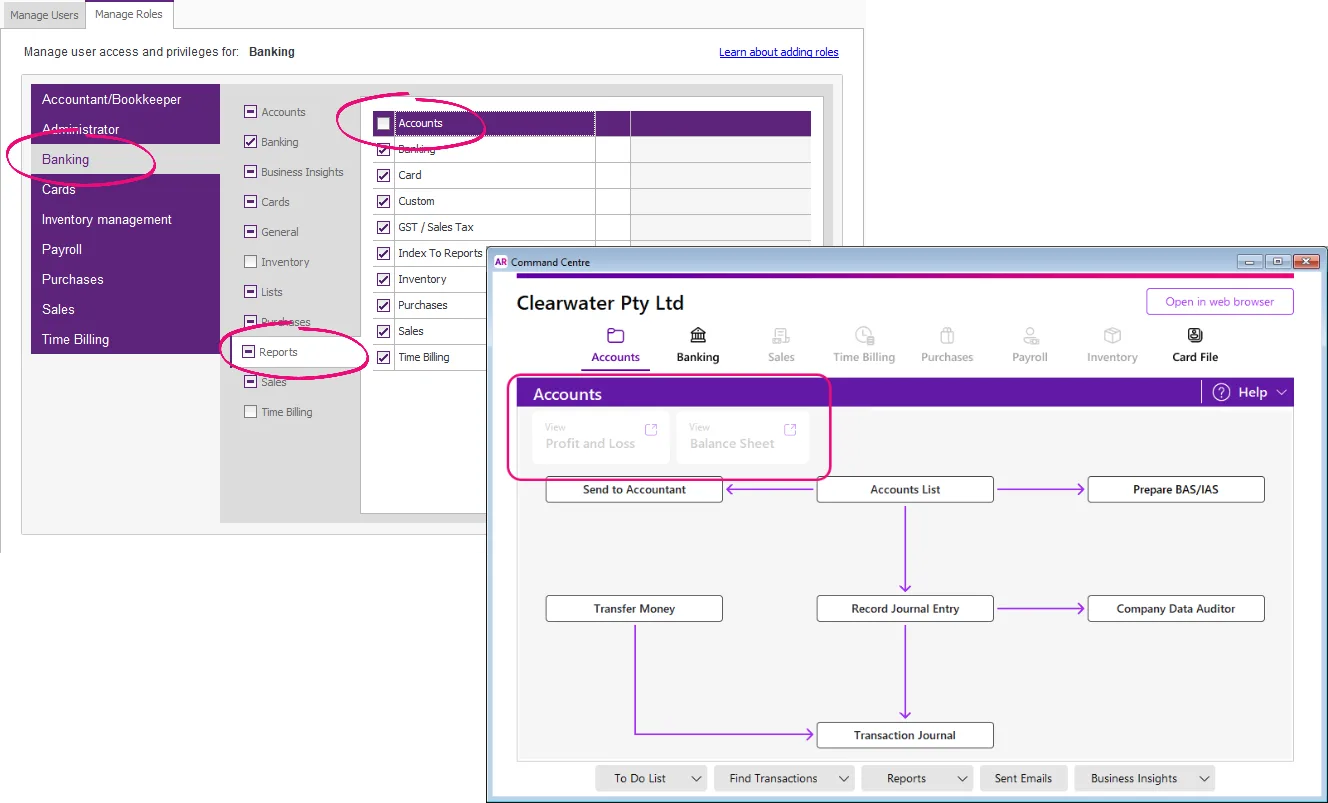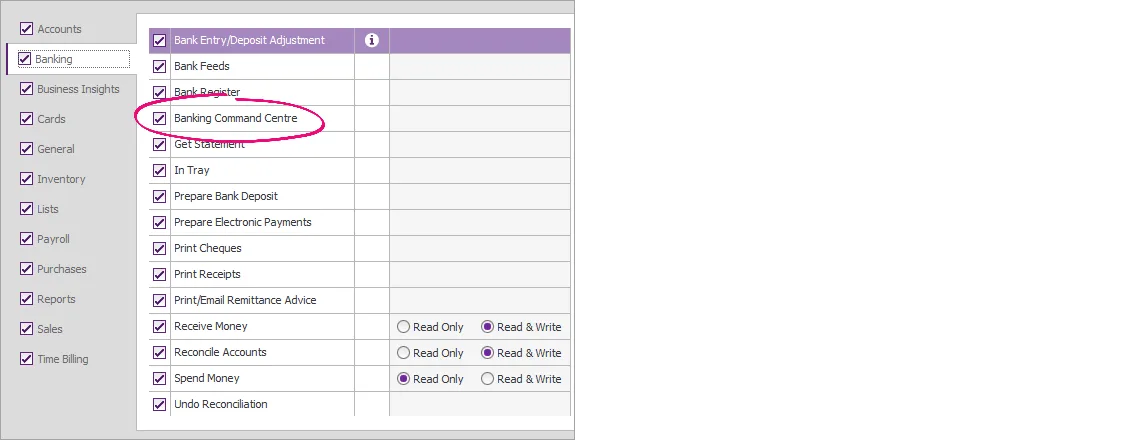Roles and permissions are used to control access to windows and functions in AccountRight. For example, if you have a salesperson on the team that you only want to be able to enter invoices, perform sales related tasks and view customer information, you can assign them the default Sales role.
However, by default, they won't be able to delete, reverse or edit sales. If you want to allow your sales staff to change transactions, you'll need to customise the role by changing its permissions.
If you want to give someone access to all features, assign them the Administrator role.

Want to allow users to edit or delete transactions? By default, only users assigned the Administrator or Accountant/Bookkeeper role can change preferences or edit and delete transactions. If you want to allow your users to change preferences or delete and reverse transactions (for example, to create a credit note), you'll need to customise the default role.
To see the permissions for each role
On the Manage Roles tab in the User Access window, click a role on the left to see its permissions on the right.
Assigning roles
You can use the User Access window, accessible from the Setup menu, to create additional user accounts and assign roles to them.
Can't see the User Access window? Only a user who has been assigned the Administrator role (or the User Access permission) can create additional user accounts and assign roles to them. See Manage users.

When creating a user account, you need to select at least one role from the Company file roles list. AccountRight comes with a set of default roles to choose from. You can customise the permissions of these roles or create new roles.
Customising roles
If you want to modify a role, click the checkboxes in the Manage Roles tab to add and remove permissions from a role. Click Save to commit the changes you make.

When you customise a role like this, the changes will affect all users who have been assigned the role.
Duplicating a role to make a custom role
If you want to create a custom role, right-click an existing role name in the Manage Roles view of the User Access window, and select Duplicate Role. Give the new role a name. All permissions selected for the role you duplicated will be selected for the new role.
You can add and remove permissions as you like. When you’ve finished modifying the role, click Save. The new role will now appear in the Manage Users view of the User Access window, so you can assign it to the relevant users.
Renaming a custom role
You can rename roles that you’ve created. Simply select the role name you want to rename and type the new name. Note that you can’t rename the default roles.
Deleting a custom role
You can delete roles that you’ve created by right-clicking the role name in the Manage Roles view of the User Access window and choosing Delete Role. If users have been assigned this role, they'll no longer have access to the windows and functions that the role entitled them to access.
Note that each user account must have at least one role assigned to them, so if the role you’re deleting is the only role assigned to a user account, you'll need to select an alternative role for them, or make the account inactive (click the Inactive User option in the Manage Users view of the User Access window).
You can’t delete the default roles.
Read Only/Read & Write options
For some permissions, you can choose the level of access to give to the user. You can give them full access (Read & Write) to a window or function, or just allow them to view but not edit information in the relevant window (Read Only). For permissions that have this option, select the access level when modifying the role in the Manage Roles view of the User Access window.
This is useful for when you want to allow a user to view the detail of transactions. For example, you might give a salesperson Read Only access to the Purchases window, so they can view details of purchases recorded, but not allow them to raise a new purchase order.
Alternatively, you can make all permissions read-only for a user. Select the user account you want to set to read-only in the Manage Users view of the User Access window and then select the Read Only option. This option will override any Read & Write permissions selected for the roles assigned to the user.
Controlling access to command centre shortcut tiles
Online company files have shortcut tiles for handy one-click access to things that need attention, key reports and common tasks.

The Administrator role gives access to all the shortcuts in each command centre and this role can't be changed.
For other roles, you can control access to these shortcuts by customising the role's permissions. For example, you might not want a user with the Sales role to view the Profit and Loss or Balance Sheet reports.. Or you might want to prevent a user from creating customer or supplier cards.
If you've assigned the same role to multiple users but you only want to customise the role for one user, you'll need to duplicate the role (see above).
Customising permissions to control shortcut access
Go to the Setup menu > User Access > Mange Users tab.
Click the user's name on the left and check their assigned Company file role on the right.

Click the Manage Roles tab.
Click the user's role on the left and set the permissions on the right to control access to the command centre shortcuts for that role.

Refer to the table below for the permission settings to control each shortcut tile.
In this example, we've used the first two rows in the table to disable the View Profit and Loss and View Balance Sheet shortcut tiles on the Accounts command centre for the Banking role.

To allow a user to see a specific command centre, make sure their role has the applicable Command Centre permission selected, e.g. Banking > Banking Command Centre.

Shortcut tile | Change this permission | What this does |
|---|---|---|
Accounts command centre |
| |
View Profit and Loss | Click the role > click the Reports permission > deselect Accounts | For the chosen role, this disables the shortcut tile and prevents access to all accounts reports. |
View Balance Sheet | Click the role > click the Reports permission > deselect Accounts | For the chosen role, this disables the shortcut tile and prevents access to all accounts reports. |
Banking command centre |
| |
Unallocated Transactions | Click the role > click the Banking permission > deselect Bank Feeds | For the chosen role, this disables the shortcut tile as well as the Bank Feeds button on the command centre. Users with this role will not be able to access the Bank Feeds window. |
In Tray Documents | Click the role > click the Banking permission > deselect In Tray | For the chosen role, this disables the shortcut tile and hides the number of In Tray documents. It also disables the In Tray button on the command centre. Users with this role will not be able to access your In Tray. |
View Reconciliation Report | Click the role > click the Reports permission > deselect Banking AND click the Banking permission > deselect Reconcile Accounts (or select Read-Only) | For the chosen role, this disables the shortcut tile and prevents access to all banking reports. Users with this role will not be able to use the Reconcile Accounts feature. |
Sales command centre |
| |
Overdue Invoices | Click the role > click the General permission > deselect To Do List | For the chosen role, this disables the shortcut tile and hides the number of overdue invoices. It also prevents access to the overdue sales transactions via the To Do List button. |
View Aged Receivables | Click the role > click the Reports permission > deselect Sales | For the chosen role, this disables the shortcut tile and prevents access to all sales reports. |
View Customers | Click the role > click the Cards permission > deselect Customer Cards | For the chosen role, this disables the shortcut tile and prevents access to view or create customers via the Cards List command centre. |
Create Customer | Click the role > click the Cards permission > deselect Customer Cards | For the chosen role, this disables the shortcut tile and prevents access to view or create customers via the Cards List command centre. |
Time Billing command centre |
| |
Create Activity | Click the role > click the Time Billing permission > deselect Activities (or select Read-Only) | For the chosen role, this disables the shortcut tile, disables the Activity List button on the command centre, and prevents the creation of activities. |
Purchases command centre |
| |
Overdue Bills | Click the role > click the General permission > deselect To Do List | For the chosen role, this disables the shortcut tile and hides the number of overdue bills. It also prevents access to the overdue purchase transactions via the To Do List button. |
In Tray Documents | Click the role > click the Purchases permission > deselect In Tray | For the chosen role, this disables the shortcut tile and hides the number of In Tray documents. It also disables the In Tray button on the command centre. Users with this role will not be able to access your In Tray. |
View Aged Payables | Click the role > click the Reports permission > deselect Purchases | For the chosen role, this disables the shortcut tile and prevents access to all purchase reports. |
View Suppliers | Click the role > click the Cards permission > deselect Supplier Cards | For the chosen role, this disables the shortcut tile and prevents access to view or create suppliers via the Cards List command centre. |
Create Supplier | Click the role > click the Cards permission > deselect Supplier Cards | For the chosen role, this disables the shortcut tile and prevents access to view or create suppliers via the Cards List command centre. |
Payroll command centre (Australia only) |
| |
View Employees | Click the role > click the Cards permission > deselect Employee Cards | For the chosen role, this disables the shortcut tile and prevents access to view or create employees via the Cards List command centre. |
Create Employee | Click the role > click the Cards permission > deselect Employee Cards | For the chosen role, this disables the shortcut tile and prevents access to view or create employees via the Cards List command centre. |
Inventory command centre |
| |
View Reorder Report | Click the role > click the Reports permission > deselect Inventory | For the chosen role, this disables the shortcut tile and prevents access to all inventory reports. |
Create Item | Click the role > click the Inventory permission > deselect Items (or select Read-Only) | For the chosen role, this disables the shortcut tile and the Items List button on the command centre. |
Card File command centre |
| |
Create Contact | Click the role > click the Cards permission > deselect Customer, Supplier, Employee or Personal Cards | For the chosen role, this disables the shortcut tile and the Cards List button on the command centre. |
Create Contact Log | Click the role > click the Cards permission > deselect Contact Log | For the chosen role, this disables the shortcut tile and the Contact Log button on the command centre. |